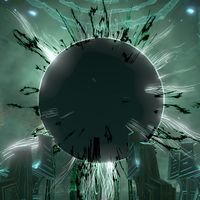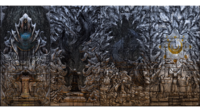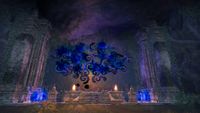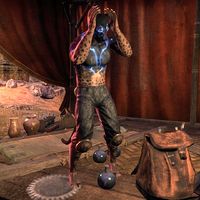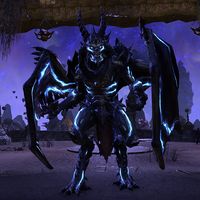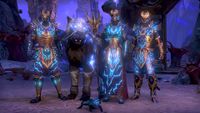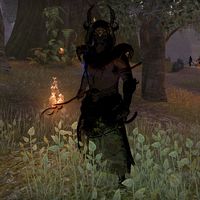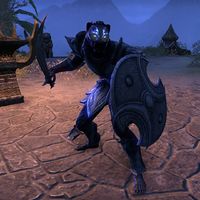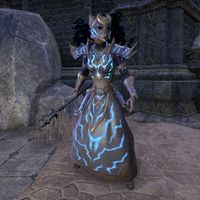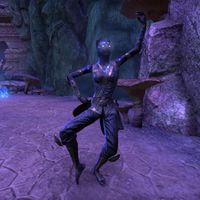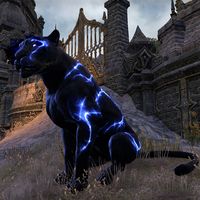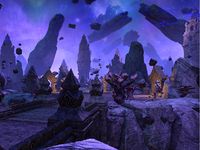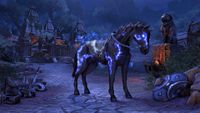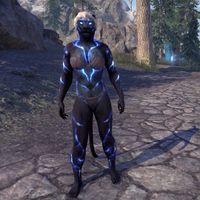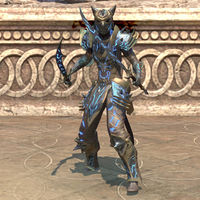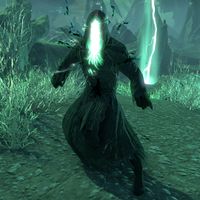Lore:Dro-m'Athra
—Rid-Thar-ri'Datta
The dro-m'Athra, or Dro-m'Athra (a word meaning dark spirits of Elsweyr),[1] are a very dangerous and seductive reflection of the Khajiit.[2][3] They are Khajiiti individuals who become corrupted in life, resulting in their souls being claimed by Namiira. Upon death these souls are ultimately lost to the Daedric Prince Namiira.[4]
Dro-m'Athra have fur that is completely black, crossed by lines of glowing blue lightning.[5] Their eyes glow pale blue.[6][7] They pour into Nirni from the Dark Behind the World, where they dance to the pounding of the Dark Heart of Lorkhaj.[4] They correspond to the inverse phases of Masser and Secunda, revealed be aspects of the more universal Daedric powers.[1] They are comparable to Shades, also creations of the Dark Heart.
Khajiit born under a dark eclipse may be eligible to become the spiritual leaders known as Manes,[1] or if they are not, they are known as Forgotten Manes.[8] Because these Khajiit were born under this lunar alignment, they are more susceptible to the moons, and thus the Dark Moon. The Dark Heart consequently calls them to the Bent Dance, which threatens to turn them to dro-m'Athra. Such was the case of the Forgotten Mane Ja'darri,[9] who managed to ward off the corruption.[10] Others are unsuccessful, with the Dark Mane being a prime example. He listened "too much to the Darks", and thus his soul was claimed by Namiira.[11] Tainted, he was no longer fit to lead the Khajiit as a spiritual leader, and was "cast out of the Moon's light, to walk forever in darkness."[12]
History[edit]
Dawn Era[edit]
The exact origin of the dro-m'Athra is obscure to the modern day Khajiit. Legends speak of warriors that went to war with the stars, but how this turned them into dro-m'Athra remains unknown.[2] In general their existence is explained with the duality of light and darkness,[13] which is uniquely present in the Khajiiti soul.[14] Just as the Khajiit are the children of Jone and Jode, the dro-m'Athra are children of the Dark Moon.[2]
Ancient scriptures predating the Riddle'Thar offer an origin, crediting their creation to Lorkhaj. After Lorkhaj's betrayal caused the other spirits to tear out his heart and cursed him to "walk Nirni for many phases",[15] he fled to Azurah with the hole in his chest. Azurah saw that Namiira still dwelled within his wound, keeping him alive and corrupting him by imitating his heart. Azurah cleansed Lorkhaj of the corruption and flung his Dark Heart into the Void, and Lorkhaj perished within Azurah's embrace.[16] From the Dark Heart came the twisted shade of Lorkhaj known as the Moon Beast, the first dro-m'Athra,[17][18] whom is said to still prowl the edges of the Lattice and pounces on Khajiit who stray too far off the Path.[18] Thus Lorkhaj represents the duality of Khajiiti souls and their susceptibility to the Bent Dance,[17][18] which calls them to darkness through the "beating drum of the Dark Heart in [their] moments of deepest sorrow or most anguished regret."[19]
Second Era[edit]
In 2E 582, at the Sathram Plantation in the Stonefalls of Morrowind, the Khajiiti slave Ra-shadda planned a slave revolt after his wife was killed by torture. Ra-Shadda's plan was to summon dro-m'Athra with an idol of the Dark Moon, and escape the plantation with his fellows amidst the chaos. In actuality, the dro-m'Athra killed everyone, slaver and slave alike, and took to wearing their victim's appearances. A squad of Ebonheart Pact soldiers were sent to stop the slave revolt, but were quickly killed off. Ruvali Manothrel, the wife of the Plantation owner, hired an adventurer to quell the unrest, driving the dark spirits away.[20]
The Dark Mane[edit]
Later that year Javad Tharn plunged Elsweyr into chaos by launching a Colovian occupation of Arenthia, under the guise of creating a beachhead for the annexation of Reapers March.[21] After taking the city, however, he ordered the Stonefire Cult to construct a Dark Anchor in secret within Arenthia's Temple District.[22] Javad also sought daedric power outside the Lord of Brutality's domain, and thus exploited the Khajiit's natural enemy, the dro-m'Athra. Reawakening their fabled Dark Mane, he used the dark spirit to possess Mane Akkhuz-ri. As the Mane represents the soul of the Khajiiti people, Javad hoped that with Akkhuz-ri's soul stained, the soul of the Khajiiti people would likewise be plunged into darkness.
Meanwhile, the Mane's lunar champions, Khali and Shazah, were forced to fight back against the invading dro-m'Athra in Fort Grimwatch, where Rid-Thar-ri'Datta appeared before them and their ally to guide them in their process of becoming Mane. He deemed that Akkhuz-ri was no longer able to serve as Mane, and bestowed the champions' ally the title of "Moon Hallowed."[23]
Javad's occupation would subsequently foiled by the Arenthian Resistance, and the Dark Mane was separated from Akkhuz-Ri. Afterwards, the Dark Mane assaulted the temple of Moonmont with the dro-m'Athra, and corrupted it. There Rid-Thar-ri'Datta reunited with the Moon Hallowed and the Lunar Champions, before they faced the Dark Mane and sealed him away within one of the Lunar Champions, who thereafter remained at Moonmont to keep the Dark Mane imprisoned, though it is unknown which performed that duty.[24]
In a last ditch effort, Javad Tharn and the Stonefire Cult had launched an attack on the city of Dune. He took refuge inside the Temple of the Two Moons Path as the Moon Hallowed as Queen Ayrenn's forces attempted to retake the city. Once the Lunar Champion and the Moon Hallowed arrived in Dune, they were able to drive out the Daedra and reclaim Dune for the Aldmeri Dominion.[25]
In the presence of the Dominion's leaders and other important figures at the Temple of the Two Moons Path, the Moon Hallowed and Lunar Champion walked the Two Moons Path, which took them to the Demiplane of Jode where they witnessed a possible future which would result in the fall of the Aldmeri Dominion in the absence of a Mane.[26] The pair persevered and made it to the last leg of their journey at the Den of Lorkhaj, where they encountered both Javad Tharn and the Dark Mane, possessing the other Champion, whom Tharn intended to have walk the Two-Moon's Path.[27] In the end, the Mane and the Moon Hallowed prevailed against Javad Tharn and the dro-m'Athra. The tainted Lunar Champion's sacrifice set her free, and she was thus was able to reach Aetherius. After their victory, at Dune, Rid-Thar-ri'Datta gave his blessing to the new Mane of Elsweyr.[28]
Post Planemeld[edit]
Namiira and her dro-m'Athra has a history with the Temple of Seven Riddles in Reaper's March. The temple was purportedly built too tall—as the Clan Mothers say, "Khajiit aren't meant to stand so close to the Ja-Kha'jay before the dead-climb."[29] The dro-m'Athra have emerged at the Temple of Seven Riddles in part because of this factor,[29] but there is also a story told among the Doubting Monks which recounts the first instance of dro-m'Athra invading the Temple.
Long ago, a Moon-Bishop referred to as the Stone-Tapper resided within the Temple of Seven Riddles. He carried a magic stick that told him secrets when he tapped it on the floor.[30] Day and night, the Bishop tapped the floor, learning all of Nirni's secrets. Eventually, the magic stick ran out of Nirni secrets, so it started telling him darker secrets: Namiira's secrets. The Tapper listened, growing old and crazy. The temple's monks went mad as well because the tapping never stopped. It was a loud and steady sound, like a heartbeat. Eventually, the monks plotted to kill the Stone-Tapper. They lured him to the High Lunarium and stabbed him. All the blood and secrets drained out of the Tapper's body and broke the Temple asunder, revealing the Maw of Lorkhaj.[30]
The next part of the story varies depending on who's telling the tale; in some versions, the Tapper awakens when his blood is drained and kills the monks with lightning. In another variation of the tale, a great winged beast bursts out of Lorkhaj's throat and eviscerates the monks.[30] Either way, the dro-m'Athra were unleashed upon the Temple. However the Stone Tapper's murderers were killed, the hole between Nirni and the Dark Behind the World was eventually closed. Seals were erected within the temple to keep the dro-m'Athra at bay, depicting the Moon-Bishop flanked by monks, summoning bent spirits.[30] These seals did not hold forever.[29]
In 2E 582, Namiira's gaze was fixed upon the temple. The Temple's abbot, Kulan-dro, heard the beating of Lorkhaj's Heart. He was driven to defile the protective seals, allowing Namiira's brood to assault the Temple and the monks within to be corrupted by the Bent Dance.[29] With the aid of the Undaunted, the Twilight Cantors drove back the dro-m'Athra and confronted the temple's abbot.[31] Reminiscent of one of the endings to the Stone-Tapper's story, a large winged dro-m'Athra named Rakkhat tore free from the Maw of Lorkhaj and attacked those who sought to close the breach. Rakkhat was put down by the Undaunted, and the Twilight Cantors resealed the Temple.[31]
Namiira struck again later that year in Black Heights. The Wall of Life, an ancient mural that is part of the village's death rite, was tainted by the dark magic of Namiira. Years prior, the Dagi painter, Dak'radhi, became vulnerable to Namiira's advances when the death of his wife shook his faith in Khenarthi. Namiira convinced the painter that Khenarthi had abandoned Dak'radhi, his wife, and their terminally ill son, whom Dak'radhi was left alone to care for. Namiira commanded him to mix a special paint using ritual components of her choosing, which he would use to leave his mark on the Wall of Life when his time came to pass from Nirni. Upon his death, Dak'radhi was transformed into a dro-m'Athra. Many years later, his influence began to seep into the Wall of Life, allowing the Great Darkness to rise from the paint he laid.[32] From then on, villagers who came to leave their mark upon the wall of life were taken by Namiira instead of Khenarthi.[33] A Twilight Cantor visited Black Heights, purging Dak'radhi's influence from the Wall of Life with the Vestige's aid.[32]
Culture[edit]
—Ezreba
The term "dro-m'Athra" has numerous translations or meanings from Ta'agra, including Dark Spirits,[2] Ghost Cats,[34] Lost Cats,[5] Children of the Dark Moon, Children of Lorkhaj,[2] Children of Namiira, Namiira's Dark Litter, Bent spirits, Moon-haters,[3] and Dancers in the Darks.[4] The short form of this name is 'mathra.[2]
Besides the dro-m'Athra, there are also Sar-m'Athra (or "Sa-m'Athra"),[35][36] which are known as dro-m'Athra senche. Rahd-m'Athra are dark Horses that bear a striking resemblance to their dro-m'Athra riders. They serve as mounts when the dro-m'Athra ride from the Dark Behind the World, although it is unknown if these horses are tangible creatures or simply spirits from the Dark Moons.[37] Dro-m'Athra skilled in the art of stealth are sometimes called dar-m'Athra.[38] Revered warriors taken by the bent dance (sometimes identified by the honorific -do) are occasionally referred to as do-m'Athra.[39] Similarly, powerful wizards taken by the Bent Dance are sometimes noted as jo-m'Athra.[40]
The dro-m'Athra exclusively appear in Khajiiti faith and culture.[41] They can be considered Daedra, insofar as the term means "not-Aedra",[11] although some regard this classification as misleading.[14] Dro-m'Athra were listed alongside various types of Daedra, but referred to as "bizarre mutants" by certain Dremora.[42]
Dro-m'Athra equipment utilizes design motifs bearing similarities to their own appearance. Their weapons and armor display repeating lines of blue lightning and the symbol of a waning moon, as this is the time they grow stronger until they reach the height of their power during the night of the new moon. This is mostly expressed by two waning moons—one for Jone and one for Jode. On dro-m'Athra staves, the Third Moon is also symbolized. The armor, especially the shoulder pieces, appear with many spikes. Atypical for Khajiit, their boots and gloves do not have open fingers or toes for their claws.[5]
Elsweyr is dotted with numerous old and forgotten temples where dro-m'Athra are imprisoned.[2][43][44] Such places can be felt vaguely by mages, such as Greenshapers.[45] Alternatively, dro-m'Athra can be summoned by rituals anywhere on Tamriel.[46] These summonings use either totems[46] or crystals.[43][47] Corrupted shrines to the moons also allow dro-m'Athra to boil up from the earth.[13] Knowledgeable mages also can directly conjure them.[48]
Corruption[edit]
Normal Khajiit revel in the light of Jone and Jode[49][50][4] and follow the teachings of Riddle'Thar.[51] These Khajiit are called True Cats.[49]
True Cats can transform into dro-m'Athra in several ways. The most common way is to be exposed to the Bent Dance (Zha'ja Lorkhaj), where only willpower can prevent a soul from giving in.[43] It is a dance without music, only following the rhythm of the beating Heart,[19] the shadowy imitation of the Heart of Lorkhaj. Khajiit can be predisposed to susceptibility to the Bent Dance by flaws of personality or strong negative feelings.[52] These Khajiit are more easily able to hear the beating of the Heart of Lorkhaj or Namiira whispering secrets to them,[53] which will drive an individual to corruption.[3][49][51] The consumption of skooma can also increase one's susceptibility to the Bent Dance. Singing near dro-m'Athra gives them a chance to twist the song to their tune and worm their way into a pure heart from there.[3]
The first sign of the Bent Dance's influence can manifest as strong pain and hearing voices in one's head.[54][55] These symptoms are not limited to Khajiit alone, though other races cannot become dro-m'Athra—they can only be possessed by them.[56][47][46] For Khajiit in particular, it starts as a twitch of the tail and the victim hearing a tune that others cannot.[57] They begin to move along with the beat, performing unsettling motions in tune with the Bent Dance.[57] As soon as a Khajiit falls to the Bent Dance, their shadows grow longer and their tail begins to twitch. As soon as the darkness outweighs the light of the moons, salvation becomes unlikely and the Khajiit is lost. They are then called Bent Cats, or Lost Cats. Their souls are then sent to the Dark Behind the World, to Namiira and Lorkhaj, where they will return upon being vanquished.[4][51][11]
Anyone can be possessed by a dro-m'Athra, but only Khajiit can become dro-m'Athra. This is due to the properties of the Khajiiti soul. They possess a sort of duality, and the capacity to make a choice that no other race has to make—they can either succumb to the Heart or not.[56] Unlike possessions enacted by normal spirits, the soul of one affected by the Bent Dance isn't driven out to make room for a new spirit. The Khajiit change physically as well as spiritually.[57] The most notable change lies with their fur, which turns black and begins to exude dark energies.[6] The Khajiit is twisted into a dro-m'Athra rather than being possessed by a spirit. When a Khajiit is finally turned by the Bent Dance, they usually begin to cause harm on Nirn until they are banished.[57]
Bent Cats tend to display hatred for the gods venerated by the Khajiiti pantheon. Notably, they mock the bright moons, whose light drowns out the Great Darkness; Khenarthi, who carries True Cats to the Sands Behind the Stars; and Azurah, who is the symbolic mother of the litter from which True Cats are born.[58][59] All dro-m'Athra seek to unleash their hatred and pain upon True Cats, for it is all they have left.[60]
Opposing Dro-m'Athra[edit]
All we can do is return them to the Darkness."
—Adara'hai, Twilight Cantor
The Khajiit just rarely speak of the dro-m'Athra, but when they do, it is only under the light of the moons.[3][11] Merely speaking of dro-m'Athra on moonless nights is feared, as it allows their creeping influence to take hold upon True Cats.[11] Khajiit who have been educated by a Clanmother or read children's stories should know about the existence of the dro-m'Athra. However, this knowledge is often just seen as fiction; stories to scare children into obeying their parents.[61][43] In temples of the Two-Moons Dance and other monasteries, the true knowledge of the dro-m'Athra and how to fight them is preserved and spread.[2][62][53][49]
The dro-m'Athra are strongest on nights when the moons are new.[5] Their influence spreads more rapidly the more victims they find at a given location,[47] or if the Bent Cats are supported by rituals or objects.[47][63] If a dro-m'Athra is in possession of a living body, as happened with Akkhuz-ri and the Dark Mane, it can experience increased strength.[13][46] By using this power, a dro-m'Athra can free other dark spirits from their prisons beneath the earth.[2][64] Dro-m'Athra can also possess non-Khajiit.[46][47] As the dro-m'Athra can generally make puppets of the dead,[65] they also sometimes kill the body they are in possession of and create an imperfect copy of it. Puppets created in this way cannot mimic speech.[66] A formerly possessed and duplicated body can be identified by open wounds that make it appear as if something tore its way out of it.[46]
The ways of opposing dro-m'Athra can be roughly separated into two methods:
- The Way of Jone is to banish dro-m'Athra by violence alone. This method is open to any combat-capable person, but it is not permanent.[4]
- The Way of Jode is to banish dro-m'Athra by rituals and songs for a very long time, sometimes permanently.[3][65] It bathes the dark spirits in pure moonlight to drive off the darkness. However, only those educated in these methods, such as moon-priests and Twilight Cantors, can perform this kind of banishment.[4]
If the Bent Dance's influence is caught early enough, an exorcism can be performed to remove the Great Darkness from a True Cat's heart. Khajiit often describe an exorcism as "straightening the tail",[65] as opposed to the "twitching tail" symbolizing the corrupted.[4] The exorcism's success depends on how far the corruption has advanced, the dro-m'Athra's strength and the victims' own willpower. Twilight Cantors are generally called upon to perform these rites.[60] If a Khajiit is being corrupted by the Bent Dance, the Chase Away Song (S'virash Sahaala) can be sung to break it. However, if the corruption is too powerful, the song ceases to work.[51] For possessed Khajiit, violence alone can force the dro-m'Athra to leave, freeing the body.[22]
Some dro-m'Athra can achieve salvation via necromancy as practiced by the Order of the Hidden Moon; they possess the bones of dead Khajiit, allowing them to fight for their true-spirited kin. If they can face the truth of their sins, and become illuminated by victory in battle to remember their true being, these souls can sometimes be freed from Namiira's grip.[52][67] However, some dro-m'Athra resist purification through these means, and cannot be saved.[68]
When one who succumbs to Namiira's influence cannot be rescued, they must be fought. Dro-m'Athra cannot be killed, only banished.[60] Prayers, songs, ritual objects, or weapons are used for permanent or long-lasting banishment.[68] Prayers, often to the moons,[69] can be wielded by moon-priests.[4][64] The Twilight Cantors use chanting and music to sing the dro-m'Athra away.[3] Sigils and magical seals can be kept active in temples to repel dro-m'Athra.[3][24]
Ritual objects can also repel dro-m'Athra who approach them. If such an object is charged with the essence of dro-m'Athra and strengthened by a prayer to the moons, it can vanquish the dro-m'Athra if it tries to possess the wielder's body.[41][46][70] The Moonlight Blade works in a similar manner. It bears an enchantment that charges by killing undead and bent spirits. Likewise, it allows the wielder to send bent spirits back to wherever they came from.[52][71] Holy relics such as Khenarthic Bells, which are rung in reverence to Khenarthi, can also be used to drive back the Darkness. The Khenarthic Bells of Black Heights on the Passage of Dad'na Ghaten are rung by the dying to announce their coming to Khenarthi, and their ringing can drown out the beating of Lorkhaj's Heart. To destroy a dro-m'Athra completely, one must fight it in its home territory, in the darkness beyond the stars.[13]
Gallery[edit]
Different types of dro-m'Athra (excluding the Dragon Frog)
Notes[edit]
- "Dro" is a title applied to wise elders, patriarchs, and grandfathers, as a sign of respect.[72][73]
- Dro-m'Athra were documented within the Infinite Archive in Apocrypha. There, copies of them were subsequently created as maligraphies, creatures composed of vivified ink manifested by stories from books, and serve as mindless extensions of the Daedric Lord Tho'at Replicanum.[74][75][76]
- The suffix -morna is added to the names of khajiit that have succumbed to the Bent Dance and became a dro-m'Athra.[77]
See Also[edit]
- For game-specific information, see the Elder Scrolls Online and Legends
 articles.
articles.
References[edit]
- ^ a b c Pocket Guide to the Empire, 1st Edition: The Elsweyr Confederacy — Imperial Geographical Society, 2E 864
- ^ a b c d e f g h i Shazah's dialogue in ESO
- ^ a b c d e f g h Adara'hai's dialogue in ESO
- ^ a b c d e f g h i Litter-Mates of Darkness — Moon-Bishop Hunal
- ^ a b c d Crafting Motif 35: Dro-m'Athra Style — Twilight Cantor Adara'hai
- ^ a b Visual appearance of Malisu in ESO
- ^ Dro-m'Athra Skin
- ^ The Pride of Alkosh — Clan Mother Hizuni
- ^ Za'ji's dialogue in ESO: Dragonhold
- ^ Ja'darri's dialogue in ESO: Dragonhold
- ^ a b c d e Moon Bishop Hunal Answers Your Questions — Moon Bishop Hunal
- ^ Akkhuz-ri's dialogue in ESO
- ^ a b c d Rid-Thar-ri'Datta's dialogue in ESO
- ^ a b Vastarie's dialogue in Elsweyr
- ^ Words of Clan Mother Ahnissi — Clan Mother Ahnissi
- ^ The Favored Daughter of Fadomai — Amun-dro, the Silent Priest
- ^ a b The Sky Spirits — Amun-dro, the Silent Priest
- ^ a b c The Dark Spirits — Amun-dro, the Silent Priest
- ^ a b Epistle on the Spirits of Amun-dro Vol 1 — Thava-ko
- ^ Events of An Unwanted Twin, Shattering Mirror, and A Story Told in Footprints in ESO
- ^ Yours for the Taking! — Catonius Libo, Aide-de-Camp to General Lavinia Axius
- ^ a b Events of Stonefire Machinations in ESO
- ^ Grim Situation quest in ESO
- ^ a b Events of quest Motes in the Moonlight in ESO
- ^ The Fires of Dune quest in ESO
- ^ The Moonlit Path quest in ESO
- ^ Javad Tharn's dialogue in ESO
- ^ The Den of Lorkhaj quest in ESO
- ^ a b c d Adara'hai's dialogue in ESO
- ^ a b c d Vazshara's Journal — Vazshara
- ^ a b Events of Into the Maw in ESO
- ^ a b Events of Chiaroscuro Crossroads in ESO: Dragonhold
- ^ Adara'hai's dialogue during Chiaroscuro Crossroads in ESO: Dragonhold
- ^ Rakkhat's dialogue in ESO
- ^ Events of quest Into the Maw in ESO
- ^ Creatures at Do'Krin Monastery in ESO
- ^ Rahd-m'Athra mount description in ESO
- ^ Dar-m'Athra Stealth Outfit costume description in ESO
- ^ Do-m'Athra Battle Armor costume description in ESO
- ^ Jo-m'Athra Spellcaster Suit costume description in ESO
- ^ a b Ra-shadda's dialogue in ESO
- ^ Loremaster's Archive - Mehrunes Dagon & Daedra in the Second Era — Lyranth
- ^ a b c d Ezreba's dialogue in ESO
- ^ Events of quest The Witch of Azurah in ESO: Elsweyr
- ^ Treethane Bowenas' dialogue in ESO
- ^ a b c d e f g Events of quest Shattering Mirror in ESO
- ^ a b c d e On the Doorstep in ESO
- ^ Events of quest Path of the Hidden Moon in ESO: Elsweyr
- ^ a b c d Trail and Tide — Moon-Bishop Hunal
- ^ The Moon Cats and their Dance — Clan Mother Ahnissi
- ^ a b c d Twilight Rites and Hymns
- ^ a b c Mazza-Mirri's dialogue in ESO: Elsweyr
- ^ a b Vazshara's Journal — Vazshara
- ^ Tashpir's dialogue in ESO
- ^ Ganniel's dialogue in ESO
- ^ a b Vastarie's dialogue during Path of the Hidden Moon
- ^ a b c d Twilight Cantors: The Exorcists of Azurah — Theyo Prevette
- ^ Dialogue overheard from dro-m'Athra in Southern and Northern Elsweyr in ESO
- ^ Dak'radhi's dialogue during Chiaroscuro Crossroads
- ^ a b c Adara'hai's dialogue during Chiaroscuro Crossroads
- ^ Akkhuz-ri's dialogue in ESO
- ^ Khali's dialogue in ESO
- ^ Events of quest Grimmer Still in ESO
- ^ a b Events of quest Grim Situation in ESO
- ^ a b c Ri'hirr's dialogue in ESO: Elsweyr
- ^ Ulov Stormwall's dialogue in ESO
- ^ Stone of Atonement
- ^ a b Stone of Banishment
- ^ Mantra of Expulsion
- ^ Ruvali Manothrel's dialogue in ESO
- ^ Shando-ri's dialogue in ESO: Elsweyr
- ^ Khajiiti Honorifics — Lady Radurra-dra of Torval
- ^ Interview With Three Booksellers — Jobasha, Codus Callonus, and Dorisa Darvel
- ^ Loremaster's Archive - Infinite Archive — Master Malkhest
- ^ Master Malkhest's dialogue in ESO: Necrom
- ^ Enemies in Infinite Archive in ESO
- ^ Cantor Izalgo's Journal — Cantor Izalgo

